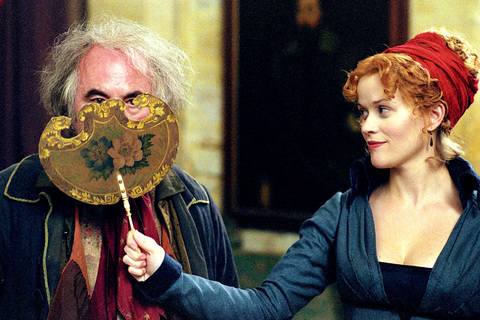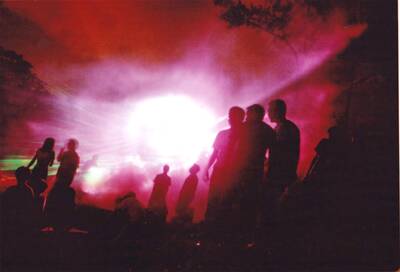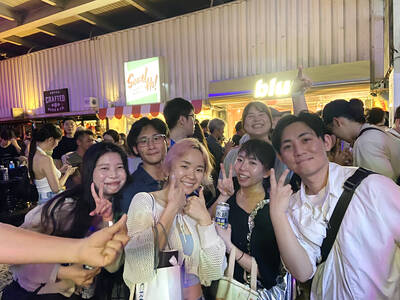Her eyes snapping like tiny firecrackers and jutting her chin, Reese Witherspoon makes an appealingly crafty Becky Sharp in Mira Nair's bland but color-drenched adaptation of William Makepeace Thackeray's 1848 novel, Vanity Fair. Witherspoon, as usual, conveys a bristly, determined spunk.
But if her performance emits enough sparks to hold the screen, it never ignites a dramatic brush fire. Despite her make-do British accent, she is quintessentially American in attitude and body language, even more a fish out of water in Vanity Fair than she seemed in The Importance of Being Earnest.

PHOTO COURTESY OF PANDASIA
Witherspoon's upbeat approach in the film, which opens today, makes her Becky more likable than other portrayals (and there have been many, most famously by Miriam Hopkins in the 1935 movie Becky Sharp, the first Hollywood feature in Technicolor).
But with its diminished gravitas, this Becky comes across as a lightweight schemer about as formidable as an aspiring trophy wife on a daytime soap. When the movie is over, you half expect Witherspoon to turn to the camera and plead, "You still like me, don't you?"
The ascent of Becky, the orphaned daughter of an impoverished artist and a French opera dancer, to the treacherous peaks of 19th-century London society and her subsequent fall from grace, plays more like the story of a cheerfully reckless flirt than of the swath cut by an unscrupulous social climber.
Becky has been cited as the literary role model for Scarlett O'Hara (a claim Margaret Mitchell denied). And as you watch Witherspoon's Becky spin her webs, you long for a lot more Scarlett O'Hara and a lot less Elle Woods.
In studiously compressing a novel that spans three decades of early 19th-century British social history into 138 minutes, the movie becomes increasingly hurried as it struggles to compress so many subplots. Eventually it loses track of time, and its refusal to show the characters aging over 30 years adds to the confusion.
The screenplay, by Matthew Faulk, Mark Skeet and Julian Fellowes, applies the same mosaic technique to Vanity Fair that Fellowes brought to Gosford Park, but the novel's daunting size prevents its being pieced into a similarly tidy jigsaw puzzle.
But Vanity Fair has a deeper conceptual confusion. In mixing satire and romance, the movie proves once again that the two are about as compatible as lemon juice and heavy cream.
The Thaceray novel is a sweeping satire of the rampant drive for upward mobility in a Britain newly flush with the wealth flowing from its colonies. Thackeray grounded the novel in an omniscient, often caustic voice looking down (and askance) at his characters and their foibles.
The movie flashes to comic life in those scenes that convey Thackeray's disdain for the preening foolishness and snobbery of early 19th-century British society and the crass symbiotic relationship between money and aristocracy.
The movie's brightest moments belong to Eileen Atkins, as Matilda Crawley, the wealthy, tart-tongued spinster who takes an instant liking to Becky for her cleverness and candid wit and adopts her as a social pet. Once Atkins fades from the movie, it never fully recovers.
At the same time, Vanity Fair toys half-heartedly with billowy romantic drama, and its token gestures emulating Gone With the Wind are too clear and clumsy to ignore.
Nair, the Indian-born director of Monsoon Wedding also can't resist embellishing the novel's connections to her South Asian roots and slaps on a contemporary multicultural gloss. Two outlandish Bollywood-flavored production numbers come off as jarring digressions that seem shoehorned in from another movie.
In the first, Witherspoon, flanked by dancers, does a grinding Indian-flavored hoochy-cooch, worthy of Britney Spears.
Byrne's Steyne may be the film's most complex character, and the movie has pungent but too-brief performances by Bob Hoskins as Pitt Crawley and Jim Broadbent as Osborne. Amelia's devoted, longtime suitor Dobbin (Rhys Ifans) is acknowledged only long enough for him to register as a piece in the puzzle.

Cheng Ching-hsiang (鄭青祥) turned a small triangle of concrete jammed between two old shops into a cool little bar called 9dimension. In front of the shop, a steampunk-like structure was welded by himself to serve as a booth where he prepares cocktails. “Yancheng used to be just old people,” he says, “but now young people are coming and creating the New Yancheng.” Around the corner, Yu Hsiu-jao (饒毓琇), opened Tiny Cafe. True to its name, it is the size of a cupboard and serves cold-brewed coffee. “Small shops are so special and have personality,” she says, “people come to Yancheng to find such treasures.” She

Late last month Philippines Foreign Affairs Secretary Theresa Lazaro told the Philippine Senate that the nation has sufficient funds to evacuate the nearly 170,000 Filipino residents in Taiwan, 84 percent of whom are migrant workers, in the event of war. Agencies have been exploring evacuation scenarios since early this year, she said. She also observed that since the Philippines has only limited ships, the government is consulting security agencies for alternatives. Filipinos are a distant third in overall migrant worker population. Indonesia has over 248,000 workers, followed by roughly 240,000 Vietnamese. It should be noted that there are another 170,000

In July of 1995, a group of local DJs began posting an event flyer around Taipei. It was cheaply photocopied and nearly all in English, with a hand-drawn map on the back and, on the front, a big red hand print alongside one prominent line of text, “Finally… THE PARTY.” The map led to a remote floodplain in Taipei County (now New Taipei City) just across the Tamsui River from Taipei. The organizers got permission from no one. They just drove up in a blue Taiwanese pickup truck, set up a generator, two speakers, two turntables and a mixer. They

Hannah Liao (廖宸萱) recalls the harassment she experienced on dating apps, an experience that left her frightened and disgusted. “I’ve tried some voice-based dating apps,” the 30-year-old says. “Right away, some guys would say things like, ‘Wanna talk dirty?’ or ‘Wanna suck my d**k?’” she says. Liao’s story is not unique. Ministry of Health and Welfare statistics show a more than 50 percent rise in sexual assault cases related to online encounters over the past five years. In 2023 alone, women comprised 7,698 of the 9,413 reported victims. Faced with a dating landscape that can feel more predatory than promising, many in